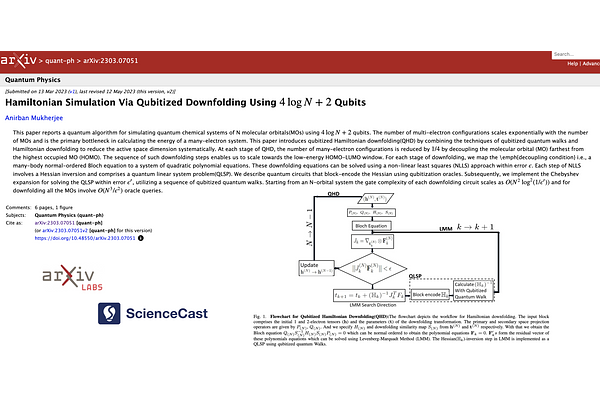Hamiltonian Simulation Via Qubitized Downfolding Using $4\log N+2$ Qubits

Hamiltonian Simulation Via Qubitized Downfolding Using $4\log N+2$ Qubits
Anirban Mukherjee
AbstractThis paper reports a quantum algorithm for simulating quantum chemical systems of N molecular orbitals(MOs) using $4\log N +2$ qubits. The number of multi-electron configurations scales exponentially with the number of MOs and is the primary bottleneck in calculating the energy of a many-electron system. This paper introduces qubitized Hamiltonian downfolding(QHD) by combining the techniques of qubitized quantum walks and Hamiltonian downfolding to reduce the active space dimension systematically. At each stage of QHD, the number of many-electron configurations is reduced by $1/4$ by decoupling the molecular orbital (MO) farthest from the highest occupied MO (HOMO). The sequence of such downfolding steps enables us to scale towards the low-energy HOMO-LUMO window. For each stage of downfolding, we map the \emph{decoupling condition} i.e., a many-body normal-ordered Bloch equation to a system of quadratic polynomial equations. These downfolding equations can be solved using a non-linear least squares (NLLS) approach within error $\epsilon$. Each step of NLLS involves a Hessian inversion and comprises a quantum linear system problem(QLSP). We describe quantum circuits that block-encode the Hessian using qubitization oracles. Subsequently, we implement the Chebyshev expansion for solving the QLSP within error $\epsilon'$, utilizing a sequence of qubitized quantum walks. Starting from an N-orbital system the gate complexity of each downfolding circuit scales as $O(N^{2}\log^{2}(1/\epsilon'))$ and for downfolding all the MOs involve $O(N^3/\epsilon^{2})$ oracle queries.
2 comments
scicastboard
- One of the major assumptions in the method seems to be the use of the Levenberg-Marquadt Method (LMM) for solving the downfolding equations. How robust is this method in handling different types of systems, and are there any limitations to using LMM in this context?
- The paper suggests that the computational bottleneck of the approach is the inversion of the Hessian matrix. Given this, how does the quantum algorithm proposed improve upon classical methods in terms of speed and efficiency?
- In the final section, the paper discusses the quantum resources necessary for block-encoding the Hessian and estimates the number of queries required for Child's quantum walk. How feasible is the implementation of this algorithm given the current state of quantum computing technology?